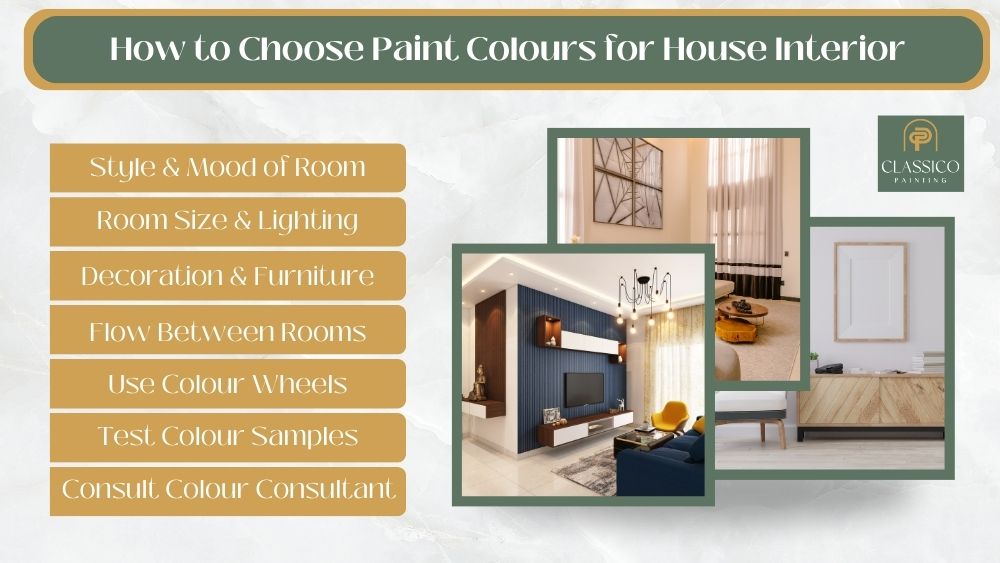You’re ready to freshen up your home’s interior, but choosing the right paint colour can be intimidating. Don’t worry! With a discerning eye and practical tips, you’ll become skilled at selecting colours that complement your style and space.
You’ll also learn about the best paint colours for bedroom and living room, selecting paint colours to make your room look larger, and how to choose exterior paint colours if you decide to venture out of the interior space.
First, let’s explore these 7 tips on how to choose paint colours for house interior.

1. Consider the Style and Mood of the Room
You’ve got to think about the style and mood you’re aiming for in each room before picking out your paint colours. If you want a tranquil oasis, consider calming blues or greens. For an energetic vibe, opt for vibrant yellows or oranges. Neutral interior paint colours like beige or grey can give a timeless elegance, perfect for classic styles.
Consider how much natural light pours into the room, affecting the colour’s appearance. Darker shades can add depth but may make the space feel smaller. Lighter hues tend to open up spaces but could feel stark without proper furnishings.
2. Check the Room Size and Lighting
Don’t forget to consider the size of your room and how much natural light it gets before deciding. When choosing paint colours, it’s crucial to understand that room size and lighting can dramatically impact the appearance of your desired shade. Smaller rooms often benefit from lighter colours, making them seem larger. Conversely, darker hues might make big spaces feel cosier.
Pay attention to the amount and type of lighting in your space, too. Natural light tends to bring out the most accurate colour, whilst artificial lighting can alter how your paint looks. So, always test a paint sample under different lighting conditions before settling on a final choice. This practical approach ensures you’ll be happy with your selection long-term.
3. Consider the Decoration and Furniture
It’s crucial to consider your current decoration and furniture when deciding on a new look for your room. The colour of your interior paint should complement, not clash with, existing pieces. For example, a lighter paint colour can provide balance if you’ve got dark furnishings.
Also, pay attention to soft furnishings like curtains and cushions. They’ll impact how the paint colour appears as well. If they’re bold or patterned, you might opt for neutral wall colours so things don’t get too busy.
Lastly, remember that it’s okay to be flexible. You might love a particular shade of blue, but if it doesn’t work with what you already have in the room, other hues in the same family could always fit better!
4. Think About the Flow Between Rooms
When considering a new look, you’ll want to think about the flow between rooms in your home. It involves creating a harmonious colour scheme that ties the spaces together. Consider your interior walls as a canvas where colours create an interconnected vibe.
Don’t randomly select colours for each room. Instead, pick a palette that flows smoothly from one space to another. For instance, if you’ve chosen a blue theme for your living room, try incorporating subtle hints of blue in the adjacent rooms. It doesn’t mean everything should be monochrome; it’s about maintaining balance and coherence.
5. Use the Colour Wheels
You’ll find the colour wheel an essential tool in deciding on your home’s theme, allowing you to visualise how various shades can complement each other. This simple device is crucial when choosing paint; it helps define and balance your colour scheme. The outer ring represents primary and secondary colours, whilst the inner circles show tertiary ones.
For a harmonious feel, select adjacent colours on the wheel. If you crave more contrast, opt for hues directly opposite each other. Don’t stop experimenting with different combinations until you pinpoint your ideal match of paint colours.
Remember that lighting also affects how colours appear, so consider this factor when choosing. Now that you’ve got a handle on using the colour wheel, it’s time to test the colour samples!
6. Test the Colour Samples
Before deciding, you must test the colour samples in different lighting conditions to see how they look. As sunlight and artificial light can alter a paint colour’s appearance, do not rely solely on the shop’s fluorescent lighting.
Paint small sections of your interior with several colour samples and observe them throughout the day. The same paint colour may appear differently depending on whether it is morning, evening, sunny, or cloudy. Even adjacent walls can display variations due to differing light angles.
This testing phase might seem tedious, but it’s necessary for ensuring that you’re content with your choice. So don’t rush this part – take your time to get the perfect paint colour for your home!>
7. Consult with a Colour Consultant
If you’re feeling overwhelmed, consulting with a colour consultant who can provide expert advice and help streamline the decision-making process is not a bad idea. They bring a wealth of knowledge, having spent years studying how colours interact and affect mood.
When choosing paint colours for your house interior, they’ll guide you through every step, ensuring your choices reflect your personality and lifestyle.
A good colour consultant doesn’t just dictate; they listen. They understand that this is your home and should feel like it. So, whether you’re moving into a new place or just giving an old one a makeover, remember: there’s no shame in seeking help. Trust their expertise to make the process less daunting and more enjoyable.
Best Paint Colours for Bedroom
Let’s delve into the world of ideal shades for your bedroom, where comfort and relaxation should be a priority. The best paint colours for a bedroom aren’t just about aesthetics—it’s also about creating an environment that reflects your personality and promotes restful sleep.
Soft neutrals, like beige or off-white, can give you a serene sanctuary feel. Blue hues help reduce stress and anxiety, making them perfect for a tranquil retreat. If you’re after something more vibrant, consider muted tones of green or lavender—they can still promote calmness without being too dull.
Choosing the right paint colours for house interiors isn’t easy, but you’ll make the right choice with some thought about what you want your bedroom to achieve.
Best Paint Colours for Living Room
Now that we’ve navigated through the best paint colours for your bedroom, let’s shift our focus to the heart of your home – the living room.
When deciding on paint colours for this space, it’s crucial to consider its multifunctionality. The living room is where you entertain guests, relax after a long day and create memories with family. Therefore, the best paint colours for your living room should reflect your style and promote an inviting and comfortable atmosphere.
Rich earth tones can instil warmth, while cool blues or greens can be calming. Remember, it’s always about balance!
Stay tuned, as next, we’ll delve into how specific paint colours can make a room look bigger.
What Paint Colours Make the Room Look Larger?
You’re probably wondering how certain shades can give the illusion of a larger space in your home, right?
Well, selecting the right paint colours for your interior plays a significant role. Light hues like white, cream, or pastels make a room look bigger. They reflect light beautifully and make spaces appear airy and open. Don’t feel limited to just whites, though! Soft tones of blue or green also have this expanding effect.
To enhance the spaciousness further, try painting your trim and wall mouldings in a lighter colour than your walls; this will make the walls appear further back.
How to Choose Exterior Paint Colours?
Moving outside your home, you must consider factors like architectural style, landscaping, and even the neighbourhood vibe when picking your palette. Let’s delve into how to choose paint colours for house exterior, intelligently.
Firstly, take a good look at your house’s structure. A colonial-style home may benefit from traditional whites, while modern architecture might stand out with bold primaries.
Don’t forget about your garden, either! If you’ve got an abundance of lush greenery or vibrant flower beds, use those as inspiration for complementary hues.
Also, remember that the paint should blend well with the surrounding homes yet stand out just enough to showcase its unique charm.





